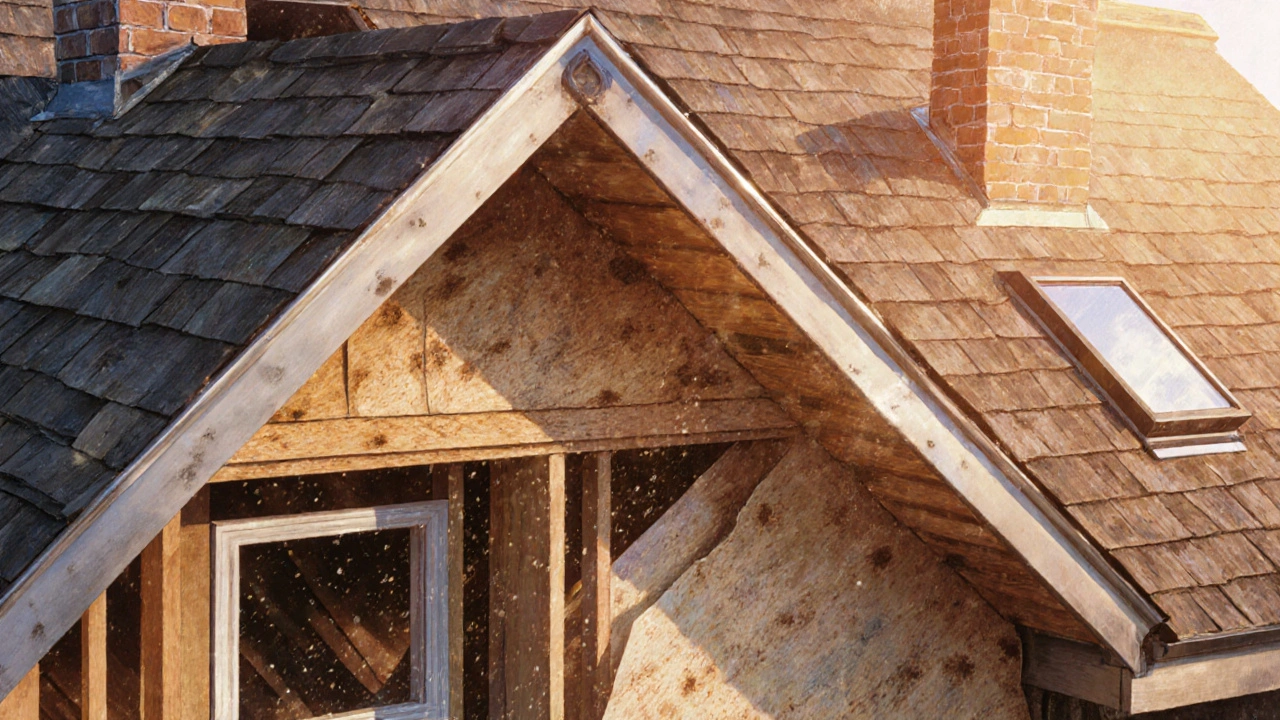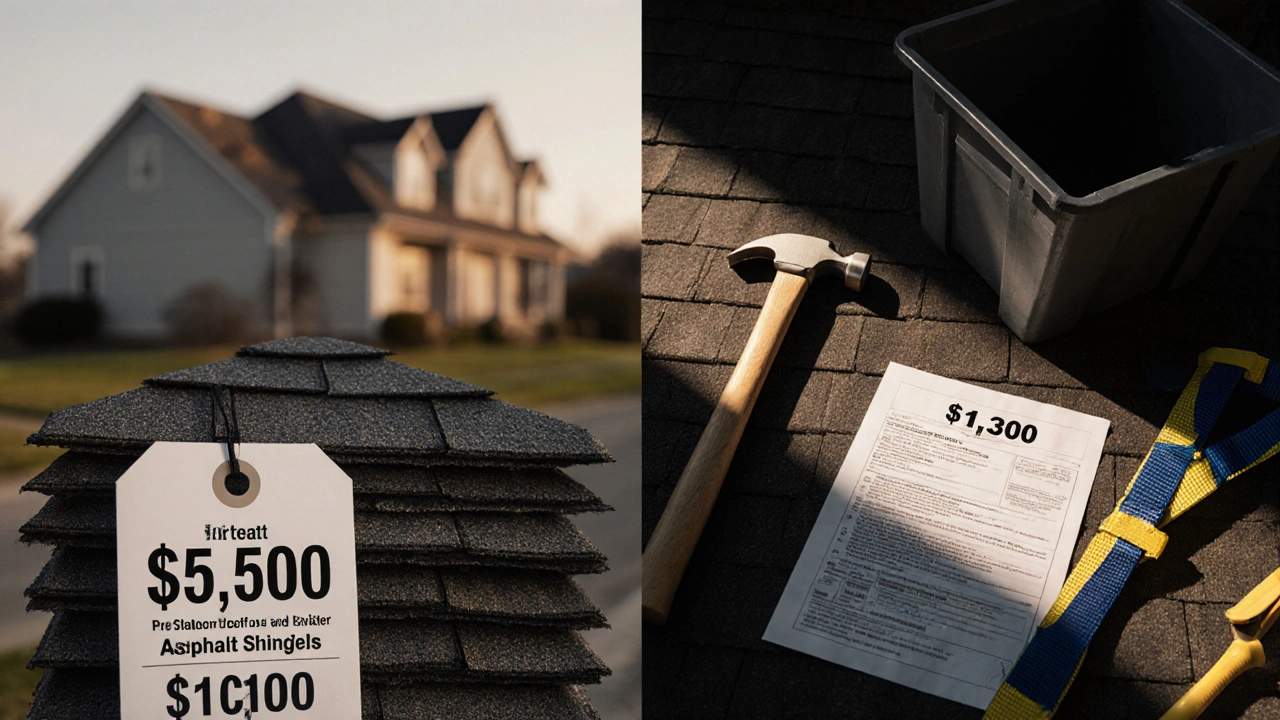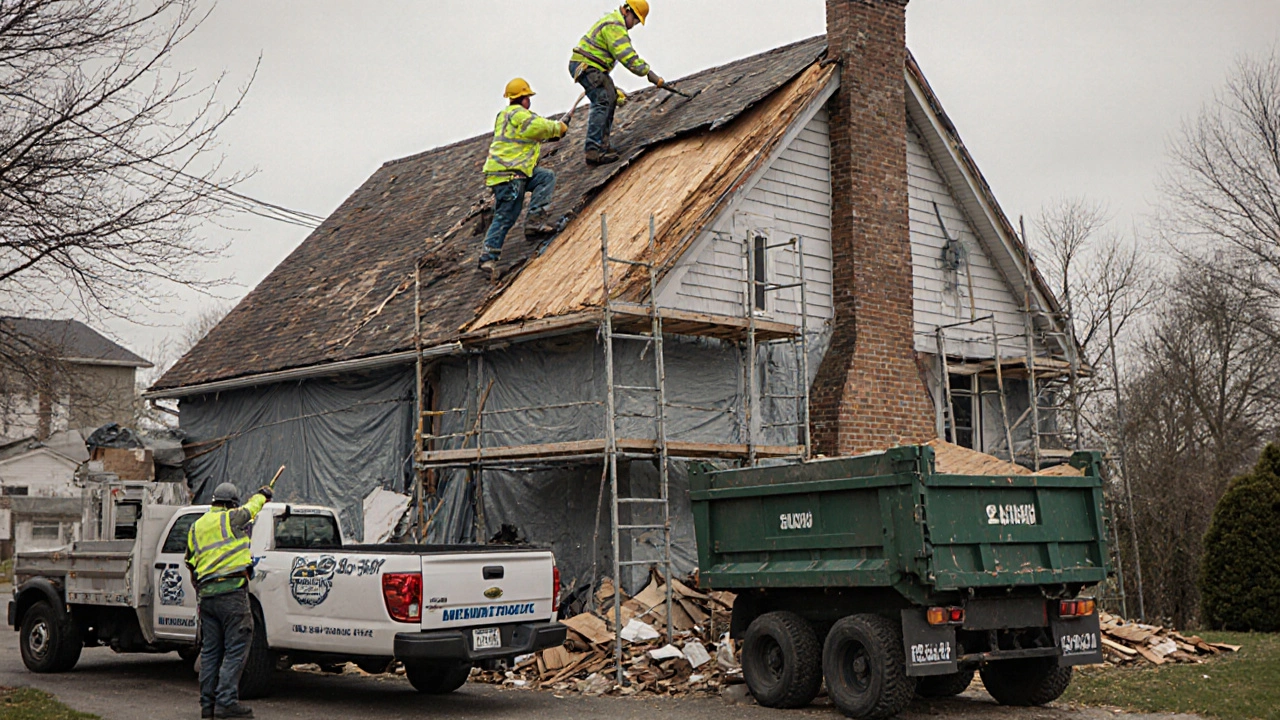When you’re planning a new roof, the big question isn’t just how much it will cost-it’s where that money is going. Most people assume the shingles are the biggest expense. They’re not. The real cost killer is hidden beneath them, and it’s not what you think.
Labor Is the Biggest Piece of the Puzzle
In a typical roof replacement in southern Ontario, labor makes up 60% to 70% of the total cost. That’s more than the materials, more than the disposal fees, more than the permits. Why? Because roofing isn’t just nailing down shingles. It’s tearing off old layers-sometimes two or three-without damaging the wood underneath. It’s hauling away thousands of pounds of debris. It’s working on a steep pitch in freezing wind, with safety gear that adds time and complexity.
Roofers don’t just show up with a hammer. They bring a crew of three to five people, a dump truck, a dumpster, scaffolding, and protective tarps. They work 10- to 12-hour days. In Burlington, where winters hit hard and summers get humid, crews can’t rush. One mistake on a 30-degree slope, and you’ve got a leaky attic by spring. That’s why skilled labor costs $4,500 to $8,000 on a standard 2,000-square-foot home, even before materials.
Underlayment and Decking Are the Silent Cost Drivers
Beneath the shingles, two things eat up your budget: the roof deck and the underlayment. The deck is the wooden base-usually plywood or OSB-that holds everything. If it’s rotted, warped, or damaged from years of ice dams, you’re not just replacing shingles. You’re replacing 20 to 40 sheets of decking. Each sheet runs $35 to $60. For a full roof, that’s $1,000 to $2,500 extra.
Then there’s the underlayment. It’s the waterproof barrier between the wood and the shingles. Asphalt-saturated felt used to be standard. Now, most pros use synthetic underlayment-it’s lighter, stronger, and lasts longer. But it costs $0.50 to $1.20 per square foot. On a 2,000-square-foot roof, that’s $1,000 to $2,400 just for the membrane. Some homeowners skip it to save money. They regret it when hail cracks the shingles and water seeps through.
Roof Pitch and Complexity Add Hidden Fees
Not all roofs are created equal. A simple gable roof with a 6:12 pitch is easy. A hip roof with multiple valleys, dormers, and skylights? That’s a nightmare. Each extra feature means more cuts, more flashing, more time. A roof with three chimneys, a solar panel mount, and a dormer can add 30% to 50% to the labor cost.
Flashing-thin metal strips around chimneys, vents, and edges-isn’t expensive by itself. But if it’s installed wrong, it leaks. And fixing a leaky flashing after the fact? That’s $500 to $1,200 per spot. Most contractors include it in the quote, but only if you ask. Don’t assume it’s covered. Ask: “Is all flashing included? What type?”

Shingles Are the Least Expensive Part
Here’s the twist: the shingles themselves? They’re the cheapest part. Three-tab asphalt shingles cost $100 to $150 per square (100 sq. ft.). Architectural shingles-more durable, better-looking-run $180 to $300 per square. For a 20-square roof, that’s $2,000 to $6,000 total. That’s less than half of what you’ll pay for labor.
And yet, everyone fixates on shingles. You’ll see ads for “$3,999 roof specials.” They’re not lying. But they’re using cheap materials, skipping underlayment, and hiring a two-person crew with no insurance. You get a roof that lasts 10 years instead of 25. And when it fails, you’re back to square one.
Waste Removal and Permits Are Easy to Overlook
Old shingles don’t vanish. They go to the landfill. In Ontario, roofing waste is classified as construction debris. A full roof tear-off generates 5 to 8 tons of material. Dumpster rental? $400 to $700. Hauling fees? Another $200 to $400. Some contractors bury it in the quote. Others charge it separately. Always ask for a line item.
Permits? In Burlington, you need a building permit for any roof replacement. The fee is $250 to $400. It’s not optional. Skip it, and you risk fines, insurance denial, or trouble when you sell. A reputable contractor handles this. If they don’t mention it, walk away.
What You Should Pay Attention to Instead
Instead of focusing on shingle color or brand, ask these three questions:
- “Will you inspect and replace any damaged decking?”
- “What type of underlayment are you using, and is it included?”
- “How many people are on the crew, and how long will this take?”
If they hesitate on the first two, they’re cutting corners. If they say “three days” for a 2,000-square-foot roof with multiple layers, they’re rushing. A proper job takes five to seven days.

Real-World Example: A Burlington Roof Job
Last spring, a home on Maple Street in Burlington needed a full replacement. The roof was 22 years old, with two layers of shingles. The deck had water damage under the ridge vent. The pitch was 8:12, with a chimney and two skylights.
The quote: $18,500.
- Labor: $11,200
- Deck replacement (28 sheets): $1,800
- Synthetic underlayment: $1,900
- Architectural shingles (22 squares): $5,500
- Flashing and vent boots: $900
- Permit and disposal: $1,200
Shingles were 30% of the cost. Labor and decking were 70%. That’s the truth.
What Not to Do
Don’t pick the lowest bid. Don’t let a salesman talk you into “premium” shingles if your deck is rotting. Don’t assume “lifetime warranty” means lifetime protection-it usually just means the manufacturer won’t replace shingles if the underlayment failed.
What you need is a contractor who checks the deck, uses synthetic underlayment, installs proper flashing, and has proof of insurance. Ask for photos of past jobs. Ask for references. Ask how they handle bad weather delays. A good roofer won’t mind.
Bottom Line
The most expensive part of a new roof isn’t the shingles. It’s the work behind them-the labor, the decking, the underlayment, the details most people never see. Spend your money where it matters: on quality installation and a solid base. The shingles will last. The structure? That’s what keeps your home dry for decades.
Is it cheaper to repair a roof or replace it entirely?
If your roof is over 15 years old and has multiple leaks, missing shingles, or sagging areas, replacement is almost always cheaper in the long run. Repairs might cost $500 to $2,000 now, but they don’t fix the underlying issues like rotting decking or failing underlayment. Those problems will keep coming back, and each repair adds up. A full replacement gives you a fresh start with modern materials and warranties.
Can I install new shingles over old ones?
Technically, yes-Ontario building codes allow one layer over another. But it’s not smart. Old shingles hide damage. They create an uneven surface that causes premature wear. They trap moisture, leading to rot. Plus, most manufacturers void warranties if shingles are installed over more than one layer. You’re saving $1,000 to $2,000 now, but risking $5,000 to $10,000 in repairs later.
What’s the best roofing material for cold climates like Burlington?
Architectural asphalt shingles are the top choice. They’re thicker, more wind-resistant, and better at shedding ice and snow than three-tab shingles. Metal roofs are great for longevity and snow shedding, but they cost 2 to 3 times more and require special installation. Wood shakes aren’t recommended-they hold moisture and are a fire risk in dry winters. For most homes in Burlington, high-quality architectural shingles with synthetic underlayment offer the best balance of price, durability, and performance.
How do I know if my roof deck is damaged?
Signs include sagging in the middle of the roof, soft spots when you walk on the attic floor, water stains on ceiling beams, or mold growth near roof penetrations. A professional will remove a few shingles and poke the wood with a screwdriver. If it’s spongy or crumbles, it’s rotted. Don’t rely on visual inspection alone-damage often hides under the shingles.
Why does labor cost so much for roofing?
Roofing is physically demanding, dangerous work done in extreme weather. Crews need training, insurance, safety gear, and equipment. A skilled crew works slowly to avoid mistakes-each nail, each seam, each flashing joint matters. In places like Burlington, where ice dams and heavy snow are common, precision is non-negotiable. Cheap labor means rushed work. Rushed work means leaks. Leaks mean expensive repairs. Paying more upfront saves you thousands later.


Amanda Ablan
November 10, 2025 AT 14:28So many people focus on shingles like they’re the only thing that matters. I’ve seen homes with fancy shingles but rotting decking underneath-two years later, ceiling’s collapsing. Labor and deck work? That’s the real insurance policy.
Janiss McCamish
November 12, 2025 AT 01:45Ask for photos of the deck after tear-off. If they won’t show you, walk away. Simple.
Kevin Hagerty
November 13, 2025 AT 23:29Of course labor costs more. Everyone’s too lazy to learn how to do it themselves anymore. Just buy a house with a roof that doesn’t need fixing. Problem solved.
Kendall Storey
November 15, 2025 AT 12:45Bro, the underlayment isn’t optional-it’s the silent bodyguard of your attic. Synthetic isn’t fancy, it’s just smart. Skip it and you’re basically inviting mold to move in with you.
Dylan Rodriquez
November 15, 2025 AT 17:39It’s funny how we treat roofs like cars-everyone obsesses over the paint job while ignoring the engine. The shingles are the exterior, sure. But the deck? That’s the frame. The underlayment? That’s the waterproofing membrane in your car’s chassis. You don’t notice it until everything falls apart. And by then, it’s too late to fix it cheaply. We’ve built a culture of quick fixes, but roofs don’t care about your timeline. They care about integrity. And integrity costs more than a viral ad can afford to show you.
That’s why I always tell people: don’t ask what’s cheapest. Ask what’s durable. Ask who stands behind their work. Ask if they’ve ever had to come back and fix a job they rushed. If they hesitate, you already know the answer.
It’s not about spending more. It’s about investing in something that will outlive your mortgage. And honestly? That’s the only kind of investment that still makes sense these days.
Meredith Howard
November 16, 2025 AT 00:13Roof replacement costs are heavily influenced by regional labor rates and material availability which vary significantly across North America though the structural principles remain consistent the emphasis on underlayment and deck integrity is universally valid though often overlooked by contractors prioritizing speed over longevity
Yashwanth Gouravajjula
November 16, 2025 AT 16:31In India we fix roofs with tar and hope. Here you fix it right. Respect.
ravi kumar
November 18, 2025 AT 09:18My uncle in Delhi replaced his roof with concrete tiles. Lasted 20 years. No underlayment. Just good slope and thick layers. Sometimes simple works.
Pamela Tanner
November 19, 2025 AT 06:10There is a critical distinction between cost and value. Many homeowners confuse the two. The lowest bid may appear economical, but it often results in higher long-term expenses due to compromised structural integrity, premature failure, and increased risk of water damage. A properly executed roof installation, even at a higher initial cost, provides measurable benefits in terms of durability, energy efficiency, and property value retention.
Kristina Kalolo
November 19, 2025 AT 12:28I had a quote last year for a 20-square roof. $16,000. They didn’t mention flashing. Turned out they were using cheap felt underlayment. Called them out. They added $1,200 and upgraded. Still cheaper than the $22k place that promised ‘lifetime warranty’ but skipped the deck inspection.
Richard H
November 20, 2025 AT 20:40Why do we pay so much for roofing? Because we let foreigners and overpaid union guys drive the prices. In my day, a guy with a hammer and a truck did it for half. Now it’s a 12-person crew with drones and apps. We’re paying for performance art, not roofing.
Ashton Strong
November 22, 2025 AT 05:37I appreciate how thoroughly this breakdown was presented. It’s rare to see such clarity on what truly matters in home improvement. The emphasis on craftsmanship over marketing is both refreshing and necessary. Thank you for highlighting the often-invisible components that ensure long-term safety and comfort.
Steven Hanton
November 22, 2025 AT 09:12It’s worth noting that the psychological tendency to focus on visible elements-like shingle color or brand-is a well-documented behavioral bias. People assign greater value to what they can see, even when the unseen structural elements are far more consequential. This is why education and transparency in contracting are so vital. The goal isn’t just to install a roof-it’s to empower homeowners to make informed decisions that protect their greatest investment.